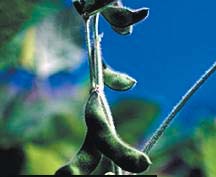| 2005 |

|
YEAR BOOK |
Institute of Technology,Tralee
|
Equol opportunities?
|

There is more local interest in isoflavone consumption with increased popularity of enriched (isoflavone containing) extracts of plants for menopause related symptoms. Reported benefits of such supplements are not experienced universally. In fact individuals have sought medical advice for side effects, apparently arising from these supplements which disappeared when the products were discontinued. What accounts for the difference between individuals trying such extracts? The final answer may be quite complicated, including factors such as genetics, lifestyle, diet and family history, but among others, scientists in I.T.T. and a local GP, are interested in one particular isoflavone.
Some people have intestinal bacteria capable of converting daidzein into a metabolite called Equol, while other people do not. Equol production has, with the other isoflavones, been associated with a lower risk of breast cancer. Equol producers are typically people who have diets rich in plant proteins, carbohydrates and fibre, and not those eating a high fat diet. Equol producers may typically have an increased ratio of 2-hydroxyestrone to 16-hydroxyestrone in their urine. This ratio of two metabolites (breakdown products) of oestradiol is thought to indicate a decreased breast cancer risk, and may be accompanied by an increased serum concentration of sex hormone binding hormone, caused by other isoflavones. SHBG helps to keep levels of free oestrogens lower � again good news when considering the risk of oestrogen-related cancer.
However, as is usually the case in a developing area of research, not every research group agrees with the effects (positive and negative) of isoflavones on human health. As yet there is no definitive study showing adults taking soy products will enjoy a reduced risk of cancer (in fact some studies suggest the opposite). However, benefits to cardiovascular system, bone metabolism and inflammatory conditions may well exist.
In conclusion, there are potential benefits and risks to the consumption of isoflavone containing products. Researchers in I.T.T. are now beginning to collect data on medical histories, the proportion of equol producers and non-producers, and the urinary oestrogen metabolite profile of a local population.
Contact: Dr Michael Hall,
School of Science, Institute of Technology, Tralee, Co. Kerry;
Tel: 066 7145600; Fax: 066 7145651;
E-mail: [email protected]